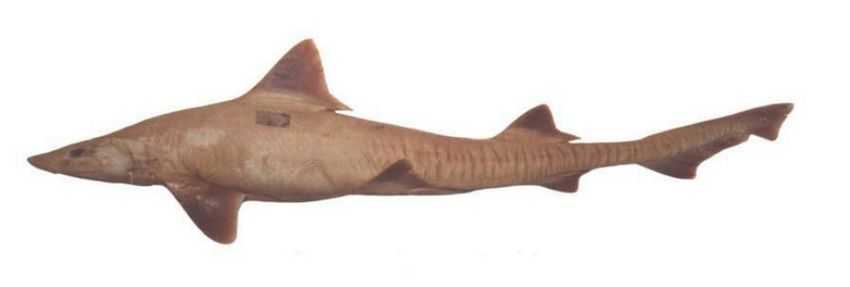Dusky Smooth-Hound

Species Details
Mustelus Canis
Triakidae
Carcharhiniformes
Onshore, Nearshore, Offshore, Reef, Wreck
15 - 27 lbs.
27" - 59"
Dusky Smooth-hound (Mustelus canis) Fish Description
The Dusky Smooth-hound (Mustelus canis) is a type of ground shark primarily found near the coasts off the Western Atlantic, Caribbean Sea, Chesapeake Bay, and the Gulf of Mexico. This shark is a popular fishing target not just for recreational anglers, but for commercial fishers as well.
This shark is relatively smaller than most sharks and much more slender. It has a tapering blunt snout and its large eyes are oval-shaped. Right behind each eye is a distinct spiracle that allows the shark to draw in oxygenated water even if it’s slightly buried in the sand. The shark has two triangular dorsal fins that are almost equal in size, with the first one just a bit bigger than the second one. Its caudal fin is deeply notched and has two asymmetrical lobes. Its coloration may vary from gray to brown on top and the underside much lighter in color, from yellowish gray to white.
Due to its small size and blunt teeth, the Dusky Smooth-hound is considered harmless to humans. This shark is often used as a lab animal and is a popular attraction in public aquariums.
Diet and Size
Dusky Smooth-hound sharks aren’t really that big as they only average more or less four feet in length. As for their swimming speed, they are often observed swimming rather sluggishly on the seabed. However, due to their long and slender body and powerful tail, they can actually swim with considerable speed when they’re on a hunt or when they feel threatened.
Like all sharks, the Dusky Smooth-hound is an adept predator and feeds mainly on large crustaceans, including lobsters, shrimp, and crabs, although it may also prey on small fish and mollusks. However, unlike other sharks, this one doesn’t have the razor-sharp teeth that sharks are known for, rather, it is equipped with flat, blunt teeth, which it uses to crush and grind its prey.
Dusky Smooth-hound Interesting Facts
- The largest recorded Dusky Smooth-hound measures fifty-nine inches in length and weighs twenty-seven pounds.
- Mating season usually happens from May to July.
- They are viviparous and gestate in about ten to eleven months.
- They can give birth between four to twenty pups in a single season.
- Their new-born pups can measure around thirteen to fifteen inches long.
- Females tend to live longer than males with average lifespans of sixteen and ten years respectively.
- Aside from humans, known predators are larger species of sharks including Blacktip and Hammerhead Sharks.
- They don’t have razor-sharp teeth like other shark species.
- They have flat blunt teeth that they use to crush and grind their prey mostly consisting of large crustaceans.
- They have two spiracles each situated behind each eye which allow them to breathe while buried in the sand.
- They are known to be opportunistic predators and are often observed to be a scavenger.
- They are considered harmless to humans and often tend to avoid than confront people.
- Commercial fishers in the US, particularly from North Carolina, Virginia, Maryland, New Jersey, and Massachusetts, catch more than two million pounds of Dusky Smooth-hounds each year.
- Although most that are caught by commercial fisheries are said to be by-catches, they are still exported to other countries.
- Dusky Smooth-hound shark meat is often served in the UK as low-quality fish and chips.
- Due to overfishing, this shark species is now under the near-threatened category by the IUCN Red List of Threatened Species.
- Fishing regulations and restrictions have been placed to help their population recover.
Fishing Tips
Catching a Dusky Smooth-hound via rod and reel doesn’t really warrant any specialized gear. Just make sure your rod-and-reel is tough enough for you to be able to reel in this small-sized shark without any hitch. Using strips of mackerel, herring and squid are said to be the best bait. You can however still use crabs, ragworms, shellfish, and prawns if the aforementioned options are not available. Because this shark is often found on or near the seabed, you will also need to present your bait as close to the bottom as possible by using a long 30lb monofilament line or a braided line with two sinkers.
Dusky Smooth-hound Habitat and Distribution
Dusky Smooth-hound sharks are most abundant along the coasts of Massachusetts, New Jersey, Maryland, Virginia, North Carolina, and both sides of Florida. They can also be found near the shores of Chesapeake Bay, Gulf of Mexico, and the insular waters of the Caribbean Sea.
The bottom-dwelling shark also prefers shallow waters less than sixty feet in depth, although they occasionally wander to the deeper parts of the water at approximately six hundred feet in depth.







